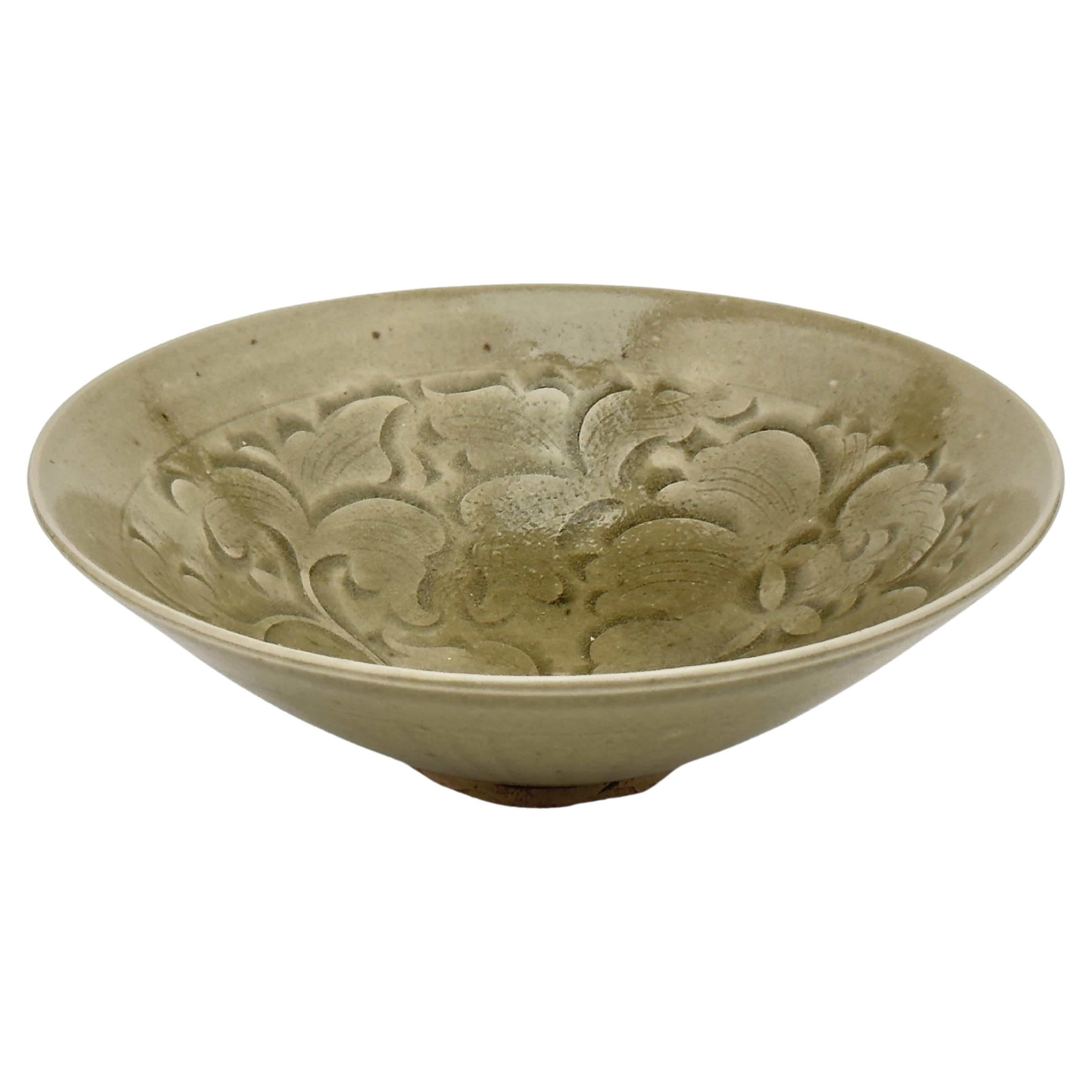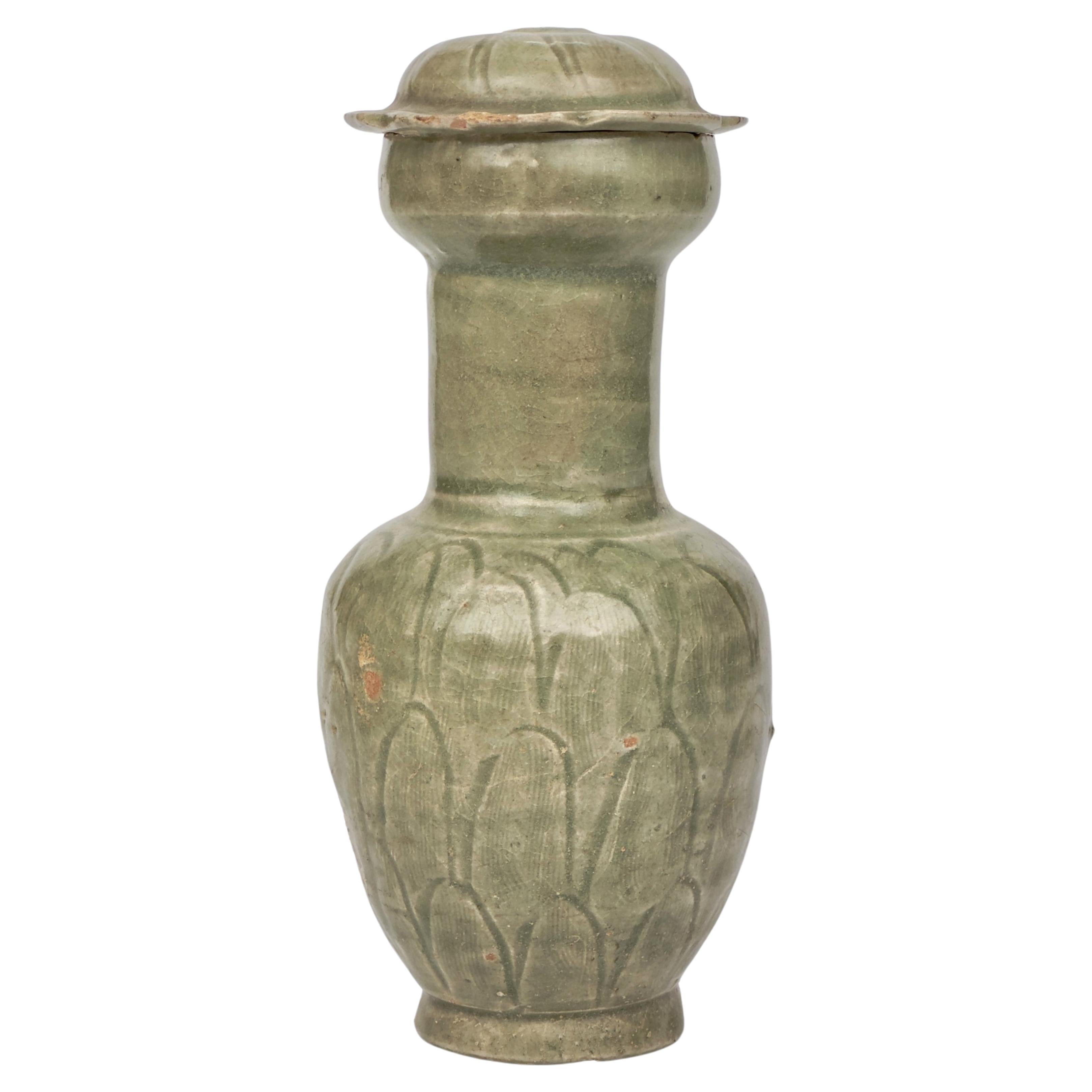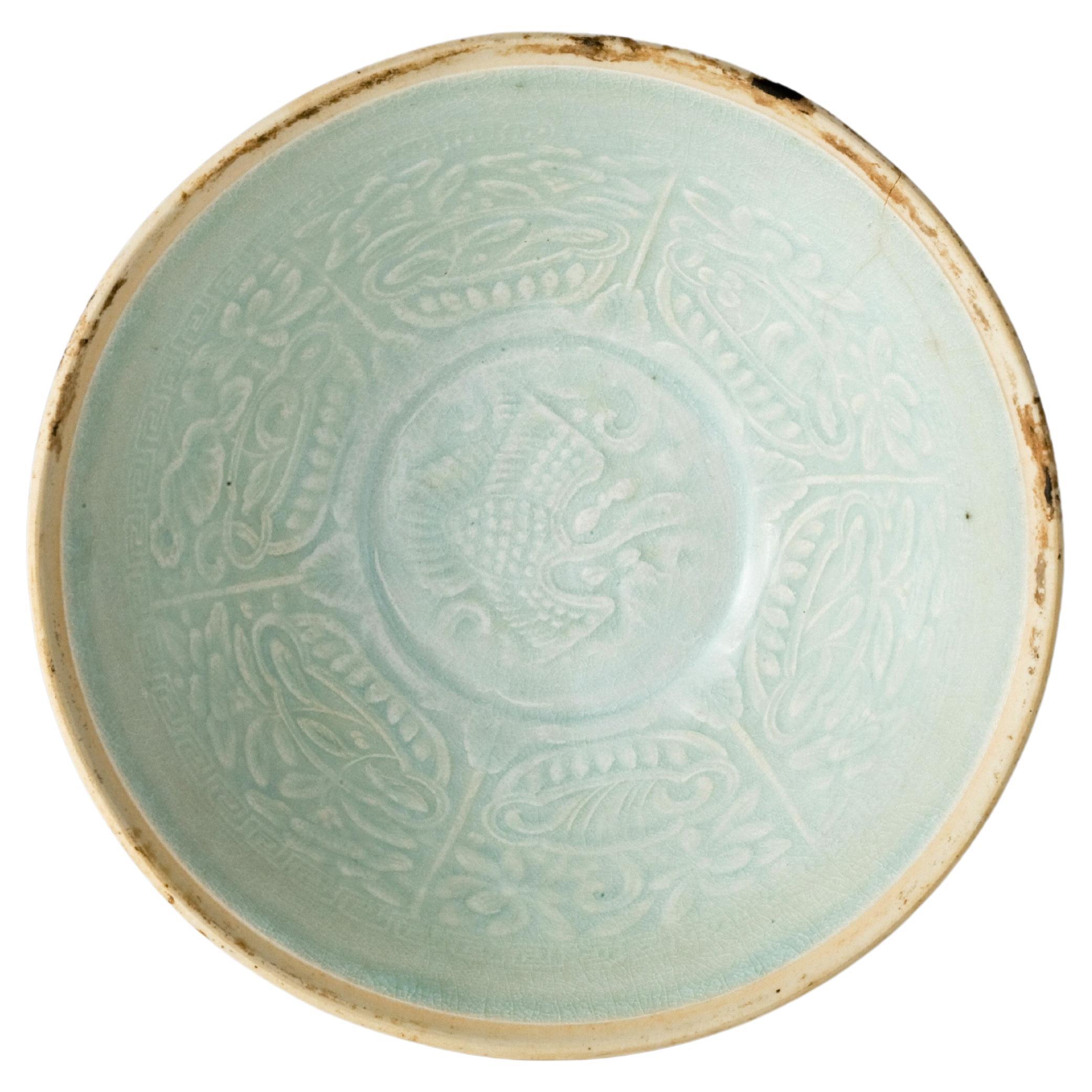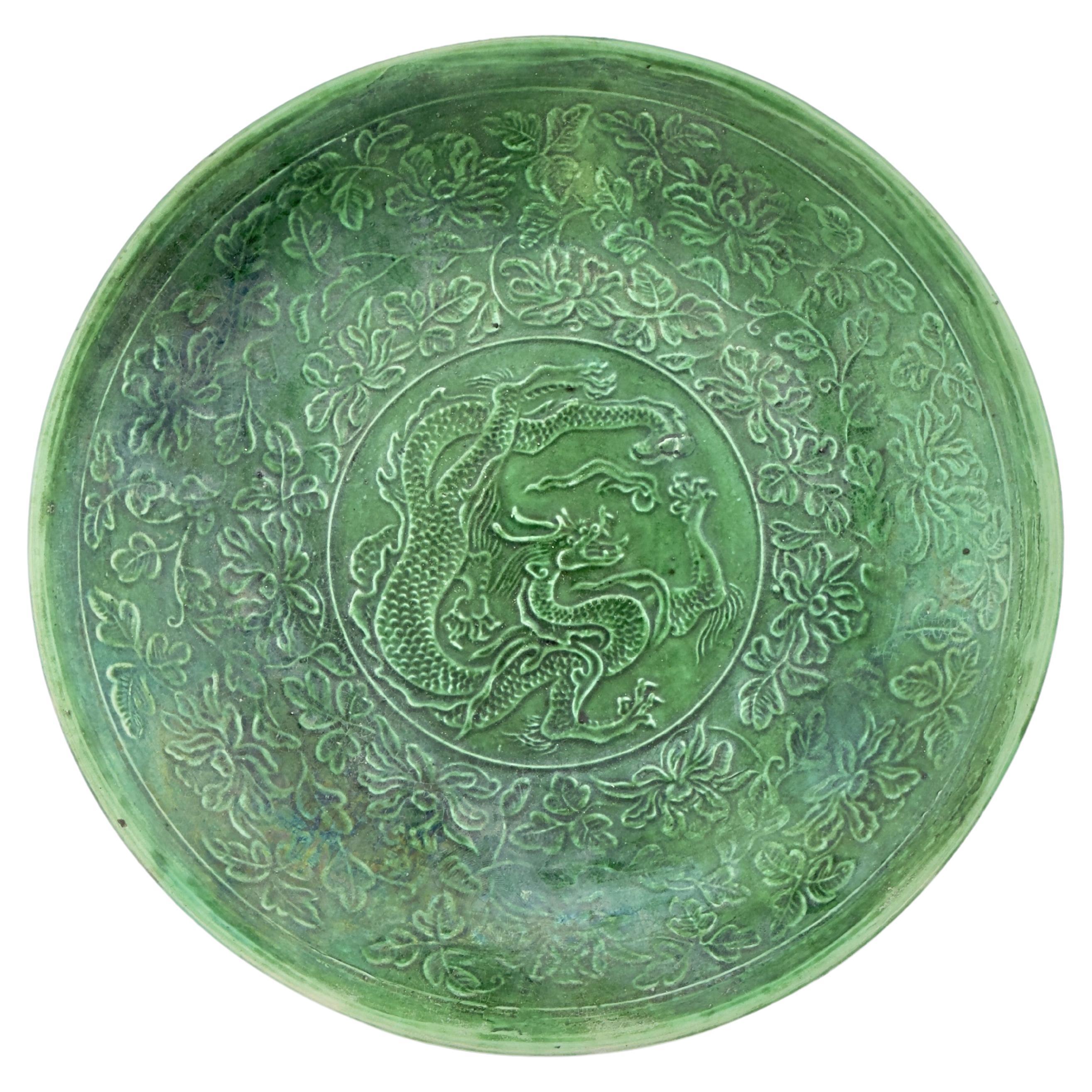Items Similar to A Rare Moulded Dingyao 'Cranes And Fishes' Bowl, Northern Song - Jin Dynasty
Want more images or videos?
Request additional images or videos from the seller
1 of 19
A Rare Moulded Dingyao 'Cranes And Fishes' Bowl, Northern Song - Jin Dynasty
About the Item
This bowl stands out for its detailed depiction of two fish amid soft spiral waves, bordered by two cranes within the bowl. The design's depth and clarity, from the lifelike portrayal of the landscape to the cranes' meticulously detailed features, render this piece exceptionally unique and rare. Such complex designs on bowls were achieved using a mold, a method initiated at the Ding kilns in the late 11th or early 12th century, enabling heightened precision. These molds, akin to those for metal vessel casting, reflect a shared design aesthetic with contemporary metal objects.
Period : Northern Song-Jin dynasty(960~1234)
Type : Dingyao
Provenance : Acquired in late 1990s, Hongkong
Dimension : 19 cm(Height) x 8cm(Diameter)
Reference :
1) Sotheby's Hongkong 29 April 2022 - Important Chinese Art including Jades from the De An Tang Collection and Gardens of Pleasure - Lot 3695, Lot 3603
(Price : 1,890,000 HKD / Type : Closely related)
2) Sotheby's Hongkong 08 October 2019 Important Chinese Art - lot 3612
(Price : 3,000,000 HKD / Type : Related)
3) Sotheby's Hongkong 22 April 2021 - Monochrome III - Lot 30
(Price : 6,000,000-7,000,000 HKD / Type : Related)
* Song Dynasty Ding-Yao Ware
Song Dynasty Ding Yao porcelain holds a significant place in Chinese ceramic art, specifically as a type of white porcelain produced during the Song Dynasty. Produced predominantly during the mid to late Song Dynasty, Ding Yao ceramics are renowned for their delicate and intricate features.
Ding Yao ceramics were primarily crafted from clay rich in white minerals and fired at high temperatures to achieve a durable and lustrous surface. One distinctive characteristic of this serene white ceramic is the presence of silver or gold-colored splashes of glaze, often created using a mineral called galena. Galena, with its lustrous appearance, was suitable for creating fine patterns and intricate decorations.
These ceramics frequently feature delicate carvings, floral motifs, or subtle decorations. While commonly used for utilitarian purposes such as tableware, Ding Yao porcelain also served as a medium for artistic expression, producing many artworks. The production of Ding Yao ceramics was relatively limited, and surviving pieces are considered rare and valuable art pieces today.
Ding Yao porcelain occupies a crucial position in the history of Chinese ceramic art, offering insights into the artistic and technological achievements of the Song Dynasty. The surviving pieces of Ding Yao ceramics are highly prized as they provide a glimpse into the artistic and technological achievements of the Song Dynasty.
- Dimensions:Height: 3.15 in (8 cm)Diameter: 7.49 in (19 cm)
- Style:Ming (Of the Period)
- Materials and Techniques:
- Place of Origin:
- Period:
- Date of Manufacture:960-1234
- Condition:Repaired: There were mild cracks along the gilted areas, but they were firmly repaired. Minor fading.
- Seller Location:seoul, KR
- Reference Number:1stDibs: LU9577239100822
About the Seller
4.5
Vetted Seller
These experienced sellers undergo a comprehensive evaluation by our team of in-house experts.
Established in 1999
1stDibs seller since 2023
5 sales on 1stDibs
Typical response time: <1 hour
- ShippingRetrieving quote...Ships From: seoul, Korea South
- Return PolicyA return for this item may be initiated within 10 days of delivery.
More From This SellerView All
- A Rare Dingyao Green-Glazed Dragon Dish, Northern Song DynastyLocated in seoul, KRThis green-glazed bowl was finely crafted with an attention to detail that highlights the skill of the Cizhou green and Ding ware potter. Its delicate form has been adorned with a dr...Category
Antique 15th Century and Earlier Chinese Ming Antiquities
MaterialsCeramic, Stoneware
- A Rare Cream-Glazed Ewer and Cover, Northern Song Dynasty (960–1127)Located in seoul, KRThe octagonal lobed ovoid body rising from a short spreading foot to a tall trumpet neck, set at the shoulder with a tall curved spout and to the other side with a tall strap handle, the dished cover surmounted with a ruyi-shaped finial, covered overall in a creamy-white glaze. Compared to other similar types of Northern Song Dynasty ceramics, this piece is extremely elegant in shape. It most closely resembles the Qingbai porcelain in the collection of The Museum of Oriental Ceramics in Osaka. Period : Northern Song dynasty(960~1127) Type : Creamy-white glaze Ewer Provenance : Acquired in 1999, Hongkong Reference : THE MET Accession Number: 18.57.1 Sotheby's London 2018 - St George Street Sale Asian Art - Lot 208 * Song Dynasty Ding-Yao Ware Song Dynasty Ding Yao porcelain holds a significant place in Chinese ceramic art, specifically as a type of white porcelain produced during the Song Dynasty. Produced predominantly during the mid to late Song Dynasty, Ding Yao ceramics are renowned for their delicate and intricate features. Ding Yao ceramics were primarily crafted from clay rich in white minerals and fired at high temperatures to achieve a durable and lustrous surface. One distinctive characteristic of this serene white ceramic is the presence of silver or gold-colored splashes of glaze, often created using a mineral called galena. Galena, with its lustrous appearance, was suitable for creating fine patterns and intricate decorations. These ceramics frequently feature delicate carvings, floral motifs, or subtle decorations. While commonly used for utilitarian purposes such as tableware, Ding Yao porcelain also served as a medium for artistic expression, producing many artworks. The production of Ding Yao ceramics was relatively limited, and surviving pieces are considered rare and valuable art pieces...Category
Antique 15th Century and Earlier Chinese Ming Antiquities
MaterialsCeramic
- Qingbai Bowl with carving of crane, Song DynastyLocated in seoul, KRThe crane, a traditional symbol of longevity and auspiciousness, is prominently placed at the center, creating a harmonious and aesthetically balanced effect. The border of the dish ...Category
Antique 15th Century and Earlier Chinese Chinese Export Antiquities
MaterialsPorcelain
- Longquan Celadon 'Lotus Petal' Jar And Cover, Northern Song Dynasty)Located in seoul, KRThe jar is sturdily potted with an oval shaped body carved with overlapping lotus petals below the straight neck. All covered with a crackled glaze of olive-green color with the exce...Category
Antique 15th Century and Earlier Chinese Ming Antiquities
MaterialsCeladon
- Carved 'Yaozhou' Celadon-Glazed Bowl, Song DynastyLocated in seoul, KRThe bowl is potted with steep, flared sides and decorated to the interior with stylized peonies among scrolling tendrils. The exterior is carved with vertical lines below the everted...Category
Antique 15th Century and Earlier Chinese Ming Antiquities
MaterialsCeladon
- Celadon Vase, Five Dynasties or Northern Song dynasty, 10th-11th CenturyLocated in seoul, KRThe form of Longquan celadon vases from the Northern Song dynasty evolved from an early design with a long neck and tapering body to a later ovoid body with a shorter neck. Over time, the glaze developed a more olive tone, and the carved decorations became more pronounced and intricate. Examples of such vases include one without a cover dated to the Yuanfeng era (1078~1085) and documented in literature, and another similar vase without loop handles preserved by the Qingyuan County Cultural Relics Bureau. An earlier example featuring loop handles and a lotus-like cover is also mentioned in historical texts. The use of Longquan covered vases, especially as funerary jars for offerings like wine and grains, was highlighted by an inscription on a piece from the Sir Percival David Collection, London. This inscription wishes for the vessel to preserve fragrant wine for centuries, blessing the owner with prosperity, longevity, and a vast lineage, dated to the third year of the Yuanfeng period (1080). This practice was common in the regions of Southern Zhejiang and Northern Fujian. A similar celadon vase from the Linyushanren collection was auctioned at Christie’s Hong Kong, emphasizing the cultural and historical significance of these artifacts. Period : Five Dynasties or Northern Song Dynasty Type : Celadon, Zhejiang province Medium : Celadon Size : 31.5 cm(Height) x 11.5(Diameter) Provenance : Acquired in late 1990s from Hongkong Reference : 1) The British Museum image id - 01613270570 2) Christies New York 23–24 MAR 2023 - Important Chinese Ceramics and Works of Art - Lot 1012 (Price Range : USD 18,000 – USD 25,000 / Type : Related) 3) National Gallery of Victoria - Accession Number - AS5-1973 * Celadon from Five Dynasties (907~960) to the early Northern Song Dynasty (960~1127) The period from the Five Dynasties (907~960) to the early Northern Song Dynasty (960~1127) marked a significant transitional phase in the development of Chinese celadon ceramics...Category
Antique 15th Century and Earlier Chinese Ming Antiquities
MaterialsCeladon
You May Also Like
- Jin Dynasty Cizhou Ware Crouching Tiger Pottery Pillow, 12th-century, ChinaLocated in Brooklyn, NYChinese Jin Dynasty 12th Century Cizhou Ware Crouching Tiger Pottery Pillow .Tiger pillow, Jin dynasty, 12th century (circa 1150) The pillow is assembled ...Category
Antique 15th Century and Earlier Chinese Ming Antiquities
MaterialsCeramic
- Chinese Ming Dynasty Period Ancient Turquoise Roof Tile with Crane and FlowerLocated in Yonkers, NYA Chinese Ming Dynasty period ancient roof tile with turquoise finish, crane and flower. Created in China during the Ming Dynasty (1368-1644), this ancient roof tile features a turqu...Category
Antique 15th Century and Earlier Chinese Ming Antiquities
MaterialsCeramic
- Chinese Ming Dynasty Period Ancient Turquoise Roof Tile with Crane and FlowerLocated in Yonkers, NYA Chinese Ming dynasty period ancient roof tile with turquoise finish, crane and flower. Created in China during the Ming dynasty (1368-1644), this ancient roof tile features a turqu...Category
Antique 16th Century Chinese Ming Antiquities
MaterialsCeramic
- Chinese Export Blue and White "Cranes" Charger Qing DynastyLocated in West Palm Beach, FLA Chinese export blue and white "cranes" charger. Qing dynasty, with a tightly scalloped edge, border of stylized motifs, the center recess representing two cranes in a stylized mar...Category
20th Century Antiquities
MaterialsCeramic
- China 960 Ad Song Dynasty Very Rare Imperial Period Offering Vessel in BronzeLocated in Miami, FLOffering vessel from the Chinese Song Dynasty (960/1279 AD ). A beautiful "offering spiritual vessel" from the Yunnan province region in the ancient China. This rare vessel was created in red bronze during the Song Dynasty period. between 960/1279 AD. This is one of the most unusual forms of red bronze jar. A large vessel, the sides are virtually perpendicular to the base. The stepped lid design is also among the more rare types. The predominant lid design among the Yunnan offering bronzes is the "wheel" pattern, with a few lids having the lotus design. This is also one of the few bronzes displaying clear riveting of a two-part vessel body, with the original twisted elements Has a combined measures including the lid of 12.5 by 8.75 inches (31.75 x 22,23 Cm). The Song Dynasty, was an imperial dynasty of China that began in 960 and lasted until 1279. The dynasty was founded by Emperor Tizu of Song following his usurpation of the throne of the later Zhou, ending the Five-Dynasties and Ten Kingdoms period. The Song often came into conflict with the contemporaneous Liao, Western Xia and Jin dynasties in northern China. After decades of armed resistance defending southern China, it was eventually conquered by the Mongol-led Yuan dynasty. The dynasty is divided into two periods: Northern Song and Southern Song...Category
Antique 15th Century and Earlier Chinese Medieval Antiquities
MaterialsBronze
- Ming Dynasty Very Rare Wooden Bust of LohanLocated in San Pedro Garza Garcia, Nuevo LeonVery serene depiction of a Lohan carved in wood, eroded with the pass of time. Lohan is the Chinese term, derived from the Sanskrit word Arhan, for a disciple or follower of Buddha w...Category
Antique 15th Century and Earlier Ming Antiquities





